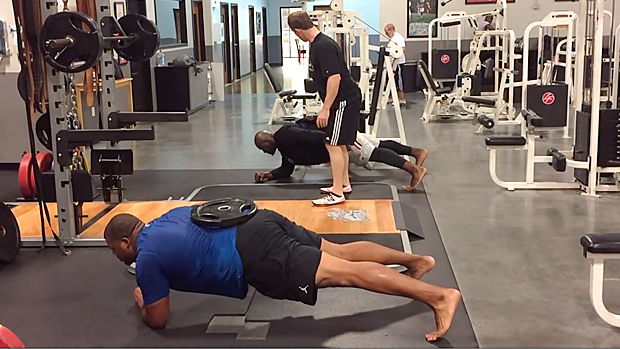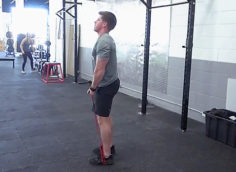Nothing beats busting your ass, blowing past sticking points, and hitting a new deadlift PR. This program is designed to do exactly that. This eight-Week plan is for high-level intermediate to advanced level lifters who have a working knowledge of their maximum strength. If you don't have a good idea of your current max, you're not ready and you need to lace up your Chucks, train a few months, and then revisit this program.
For years I trained with frequent, near maximal intensity sessions. I thought, "How could a strength-minded individual get stronger without pushing intensity above 90% for multiple sets?"
Injuries, plateaus, and frustrating sessions changed this. Training isn't about putting your body through the most hell possible; it's about maximum benefit while minimizing risk and making consistent progress.
To that end, I now base training maxes on 95% of competition max, similar to the 5/3/1 philosophy. This is to spare the nervous system, train speed, and decrease injury risk.
Exercise variation is difficult to program. Too much variation and you'll stay weak and puny; too little variation and you'll plateau, suffer overuse injuries, and smash your head into the wall out of sheer boredom.
This program uses snatch-grip deadlifts, deficit deadlifts, deadlifts from blocks, and conventional deadlifts to train weak points without detraining the specific motor pattern.
We'll use box jumps first to harness the powerful effects of potentiation and neural recruitment. Post-activation potentiation occurs primarily in type 2 fast twitch muscle fibers, so this advanced technique is used to maximize performance of explosive activities like weightlifting and sprinting.
With the nervous system primed to fire on all cylinders, you maximize explosive power and speed off the floor, leading to greater recruitment.
Don't reach for the highest box – no one cares what you're jumping on. Instead, focus on triple extension and landing flush on the box.
Note: Remember to base all numbers off your training max, not your actual max.
Week 1
| Exercise | Sets | Reps | Load | |
|---|---|---|---|---|
| A | Box Jump | 3 | 5 | 31 in. * |
| Deadlift from Blocks Warm Up | 3-4 | 30-60% | ||
| Take care of dynamic speed work. Lift each rep as if it's your max. Perform three or four ramping sets @ 30-60%. | ||||
| B | Deadlifts Pull from Blocks (2 inches) | 4 3 |
3 3 |
80% 85% |
* or a suitable but challenging height for your abilities
Week 2
| Exercise | Sets | Reps | Load | |
|---|---|---|---|---|
| A | Box Jump | 4 | 5 | 31 in. |
| Speed Deadlift Warm Up | 3-4 | 30-60% | ||
| Perform three or four ramping sets @ 30-60%. | ||||
| B | Speed Deadlift | 5 1 1 3 |
1 1 1 1 * |
65% 70% 75% 80% |
* Rest 1-2 minutes.
Week 3
| Exercise | Sets | Reps | Load | |
|---|---|---|---|---|
| A | Box Jumps | 3 | 3 | 37 in. |
| Deficit Deadlift Warm Up | 3-4 | 30-60% | ||
| Take care of dynamic speed work. Lift each rep as if it's your max. Perform three or four ramping sets @ 30-60%. | ||||
| B | Deficit Deadlift standing on 1-inch mat singles up to 92.5% | 1 | 92.5% | |
Week 4
| Exercise | Sets | Reps | Load | |
|---|---|---|---|---|
| A | Box Jump | 5 | 2 | 37 in. |
| Deficit Deadlift Warm Up | 3-4 | 30-60% | ||
| Lift each rep as if it's your max. Perform three or four ramping sets @ 30-60%. | ||||
| B | 2-inch Deficit Snatch-Grip Deadlift straps allowed | 6 | 5 | 70-75% |

Week 5
| Exercise | Sets | Reps | Load | |
|---|---|---|---|---|
| A | Box Jump | 4 | 2 | 40 in. |
| Max Effort Deadlift Warm Up | 3-4 | 30-60% | ||
| Lift each rep as if it's your max. Perform three or four ramping sets @ 30-60%. | ||||
| B | Max Effort Deadlift | 1 | 105-110% | |
| Ramp singles to 105-110% @ Training Max (full suit). | ||||
Week 6 (14 Days out)
| Exercise | Sets | Reps | Load | |
|---|---|---|---|---|
| A | Box Jump | 3 | 2 | 40 in. |
| Speed Deadlift Warm Up | 3-4 | 30-60% | ||
| Perform three or four ramping sets @ 30-60%. | ||||
| B | Speed Deadlift Full Gear | 4 3 2 1 |
1 1 1 1 |
70% 80% 85% 90-95% |
Week 7 (7 days out)
| Exercise | Sets | Reps | Load | |
|---|---|---|---|---|
| A | Box Jump | 3 | 3 | 40 in. |
| Speed Pulls Warm Up | 3-4 | 30-60% | ||
| Perform three or four ramping sets @ 30-60%. | ||||
| B | Speed Pulls Full Gear | 4 2 |
1 1 |
75% 80% |
Week 8 (meet or PR Week)
| Exercise | Sets | Reps | Load | |
|---|---|---|---|---|
| Warm Up | 3-4 | 30-60% | ||
| Lift each rep as if it's your max. Perform three or four ramping sets @30-60%. | ||||
| Optional | 1 2 1 |
1 1 1 |
60% 70% 80% |
|
| Set new personal record! | ||||
Weeks 1-3 ramp up intensity, using both pulls from blocks and deficit pulls to up-regulate the nervous system and provide variety without detraining the movement pattern.
Week 4 is a deload using the snatch-grip deadlift. The greater range of motion and difficult grip require that a lighter load be used. Make no mistake, these are still difficult.
Week 5 is all out. Suit up if you wish and work up to singles as high as 105-110% training max. If preparing for a meet, find your opener with this workout. Match or hit a PR, slap ass with your buddies, and go kiss pretty girls.
If planning for a meet, Week 6 would take place 14 days out. Suit up and do ramping singles up to 90 or 95% training max. Don't grind reps, stay explosive!
Tapering begins in Week 7, as pre-deadlift box jumps become optional. Not feeling fresh? Don't sweat it and skip the jumps. Suit up and pull explosive singles up to 80% training max but no higher.
Week 8 is meet Week or max-out Week. Dial things back until your big day, work up to 60% for 3 sets of 2 if necessary three days before. The only training goal is to feel some weight and get mentally ready.
You've heard it before but it bears repeating; Accessory work is meant to assist, not be your focus. No one cares how many glute-ham raises you can do or what you leg press.
Quit majoring in the minors and focus on the important lifts. Select auxiliary exercises based on weaknesses and sticking points, picking two to four exercises for 2-4 sets of 8-15 reps per set. If you're using Olympic lifts, keep reps between 2 and 5, emphasizing triple extension and speed.
| Issue | Weakness | Solution |
|---|---|---|
| Mid-Point Stick | Too slow, weight too heavy, lower back weakness | Speed pull, Olympic lifts from hang, mid-shin pin pull, reverse hyper |
| Poor Lockout | Weak Glutes | Glute activation, hip thrust, pull-through |
| Drifting Bar | Weak Lats | Chin-up, row |
| Low Back Rounding | Weight too heavy, low back too weak | Varying deadlift variations, deficit pull, good morning, reverse hyper |
The deadlift is the purest form of strength in sports. Pull yourself to a loaded bar, drive your heels into the earth, and stand up.
As with any training program you need to address your own individual needs and weakness, but this serves as a great template for intermediate and advanced lifters. Get dynamic with your training and carefully program auxiliary exercises as they fit.





